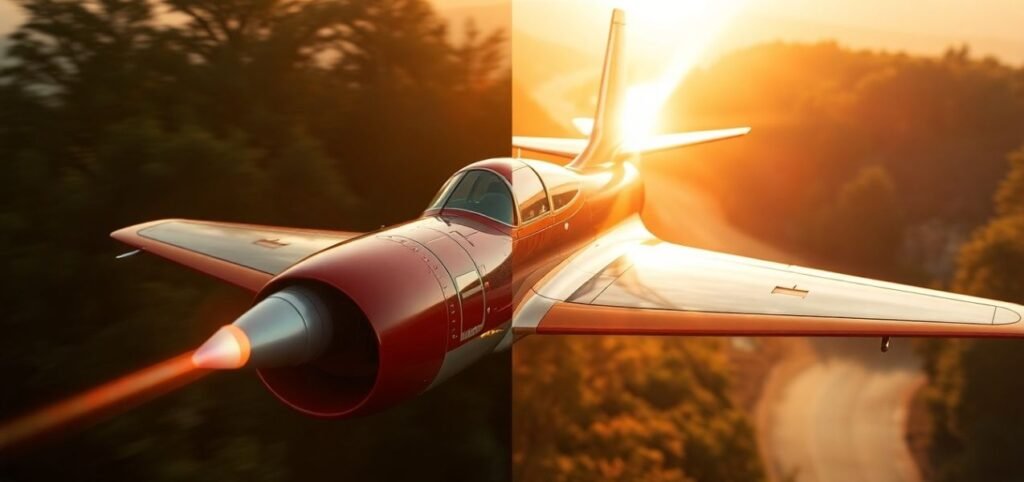The invention of the flying jet or jet aircraft is one of humanity’s greatest achievements. Jet engines have revolutionized air travel, enabling people to cross continents and oceans in mere hours. But who invented the flying jet? The story involves brilliant minds, groundbreaking technology, and a race to revolutionize the skies. Let’s dive into the history of the flying jet and its evolution.

Invention of the Flying Jet
Early Ideas of Jet Propulsion
The concept of jet propulsion goes back thousands of years. The ancient Greeks understood the basic principle of using force to propel objects, as demonstrated by the aeolipile, a steam-powered device invented by the Hero of Alexandria in the 1st century AD. While it wasn’t an engine for flying, it showcased the idea of using expanding gases for motion.
Fast forward to the early 20th century, when aviation pioneers began exploring more advanced propulsion systems. Early airplanes relied on propeller engines, which were efficient but had limitations in speed and altitude. Engineers dreamed of a faster, more powerful alternative.
The First Jet Engine: Frank Whittle and Hans von Ohain
The flying jet as we know it emerged from the work of two key figures: Frank Whittle of Britain and Hans von Ohain of Germany. Both men independently developed jet engines in the 1930s, laying the foundation for modern jet-powered flight.
- Frank Whittle: A British Royal Air Force (RAF) officer and engineer, Frank Whittle is often credited as the “father of the jet engine.” In 1930, he patented the design for a turbojet engine, which used air compression and fuel combustion to create thrust. His prototype, built in the late 1930s, demonstrated the feasibility of jet propulsion. The first jet-powered aircraft based on his engine, the Gloster E.28/39, successfully flew in 1941.
- Hans von Ohain: Around the same time, German physicist Hans von Ohain was working on a similar concept. He developed the world’s first operational jet engine, which powered the Heinkel He 178, the first jet-powered aircraft to take flight in 1939. While von Ohain didn’t know about Whittle’s work, both engineers arrived at similar solutions to the challenges of jet propulsion.
Both Whittle and von Ohain deserve recognition for their contributions, as their parallel efforts marked the beginning of the jet age.
The Race to Develop Military Jets
World War II played a significant role in accelerating jet technology. Germany led the way with the development of military jets like the Messerschmitt Me 262, the world’s first operational jet fighter. Introduced in 1944, the Me 262 was faster and more powerful than any propeller-driven aircraft of its time. However, it came too late in the war to change Germany’s fortunes.
Britain and the United States quickly followed with their own jet-powered aircraft, such as the Gloster Meteor and the Bell P-59 Airacomet. These early jets laid the groundwork for post-war aviation.
The Post-War Jet Boom
After World War II, jet technology advanced rapidly. Engineers focused on making jets faster, safer, and more efficient. The 1950s saw the rise of commercial jetliners, beginning with the de Havilland Comet in 1952. Although the Comet faced early design issues, it marked the start of a new era in air travel.
In 1958, the Boeing 707 became the first successful commercial jetliner, transforming global transportation. Its speed and capacity made it possible for people to travel between continents in hours instead of days, revolutionizing tourism and trade.
The Science Behind Jet Engines
Jet engines work on a simple principle: air compression and combustion. Here’s how it works: (Flying Jet)
- Air intake: Air is drawn into the engine at high speed.
- Compression: The air is compressed, making it highly dense.
- Combustion: Fuel is injected into the compressed air and ignited, creating hot gases.
- Exhaust: The hot gases are expelled at high speed, creating thrust that propels the aircraft forward.
This basic process, known as the Brayton cycle, is used in all modern jet engines.
Modern Innovations in Jet Technology
Today’s jet engines are far more advanced than the early designs of Whittle and von Ohain. Modern jets are: (Flying Jet)
- Fuel-efficient: Advances in materials and aerodynamics have reduced fuel consumption.
- Supersonic and hypersonic: Jets like the Concorde once allowed passengers to travel faster than the speed of sound, and companies are now working on the next generation of supersonic and hypersonic aircraft.
Military jets, such as the F-35 Lightning II, feature advanced stealth and maneuverability, showcasing how far the technology has come.
The Legacy of Jet Invention
The invention of the flying jet has transformed the world. It has brought people closer, opened up new opportunities, and changed the way we think about speed and distance. While Frank Whittle and Hans von Ohain were the pioneers, the development of jet technology is a story of global collaboration and innovation.
From the first flight of the Heinkel He 178 to today’s cutting-edge aircraft, the journey of the flying jet is a testament to human ingenuity and the desire to push the boundaries of what’s possible.
